The acuity of fairies’ vision
Добавлено: 26 фев 2020 06:53
“
— I thought… this is a fairy-tail…
— It is. But so what? Since this is a fairy-tail, what makes you think that the laws of physics stop working here? Imagine what would happen in a fairy-tail world if gravity would not work there. What about friction? Or if solar energy wouldn’t warm up Earth! Are aerodynamic laws any different in that sense?
How clear can a fairy see? Can science help us with this question?
Yes, it can. And we don’t need to catch even one specimen for that. All we need to know is her pupil size. Thanks to our previous fairyology paper, we know that a fairy’s height is about 10 cm.
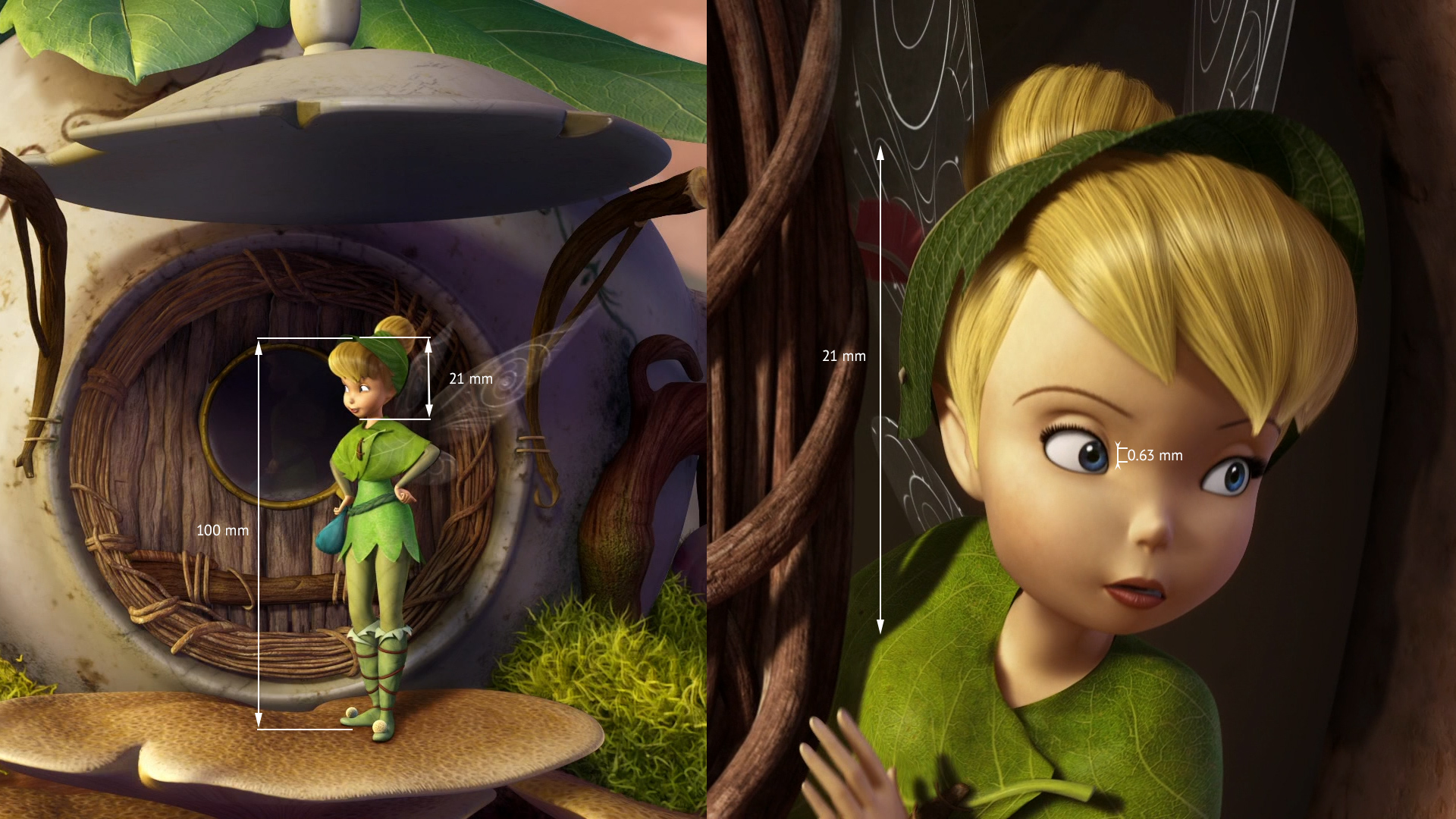
Easy enough. What now? Should we build a camera with such a tiny lens and take a couple of pictures? That would be great! Moreover, such cameras exist already. They are usually used for medical and engineering purposes. Take a look at this insect:
https://youtu.be/B3z5XV8iH9I
This is a clear hint that a fairy would see many microscopic details much, much better than a human. And it’s not a big surprise.

And what about panoramic views? Unfortunately, no one bothers filming anything with it other than tiny objects. This is the best recording I found:
https://www.youtube.com/watch?v=d0j3Ca7xoYA
If you have a similar camera, please conduct such an experiment and film an open area using it.
In this example, we can see a tiny bit of the room. And to be honest, the clarity is not too bad. Notice how dark it is. And you may already know why. The lens is tiny, and the poor sensor just doesn’t receive enough photons to show us a clear picture. The smaller the camera, the more noise and worse image quality we get.
Does it mean that a fairy sees everything darker and with such noise?
Not necessarily! You might have noticed that photographs become noisier in low light conditions, while a human eye doesn’t see this noise (although human’s pupil might be even smaller than an objective of a camera). Two final pieces of the puzzle are the sensors and the processing of the image. We can only speculate how a fairy’s retina works and how the signals are processed. Instead, let’s take a look at this demo:
https://youtu.be/qWKUFK7MWvg

Impressive? How is it possible to restore so many details from an almost dead photo? Well, one might hire digital artists (maybe from my team) and let them do the job, but in this case, we have something more interesting.
The new program benefits from the artificial neural networks, smart algorithms that somewhat resemble the human brain. First, the scientists show to the program a very dark photograph (a bad one) and the same image, but with the correct exposure (a good one). After showing several thousands of such bad and good pictures, the computer managed to “learn” how to restore dark, noisy images. Let me stress it: the machine could generalise the approach and use this “skill” to correct the new pictures never seen previously.
Source: http://cchen156.web.engr.illinois.edu/p ... PR_SID.pdf
That means that slightly darker world is not a big problem. A fairy can theoretically process the image, so it doesn’t look dark and noisy. Hey, you do it daily and don’t even notice it!
However, no processing can defeat the diffraction limit.
Don’t panic and let me explain what it means.
Granted that we don’t know what crystalline lens might fairies have, but we can measure their maximum possible acuity just by knowing the pupil size. All thanks to the wave nature of light.
Imagine water waves hitting the small opening:

Source: http://labman.phys.utk.edu/phys222core/ ... single.htm
Notice how parallel waves spread out and move radially. The smaller the opening, the more spread we get. Light behaves precisely like that with the only difference: the light waves are much, much smaller.
And how does the small opening affect the quality of the picture?
If we asked a photographer about small and large aperture (gap in the objective), he would start telling us about f-stops, exposure, depth of field and other stuff. However, almost everyone omits one important detail. Let me show you the diffraction limit in action. I printed out one page from the script of our next animated episode about Tink and Vidia. I printed the Russian version on purpose, so you don’t get distracted. Here it is:
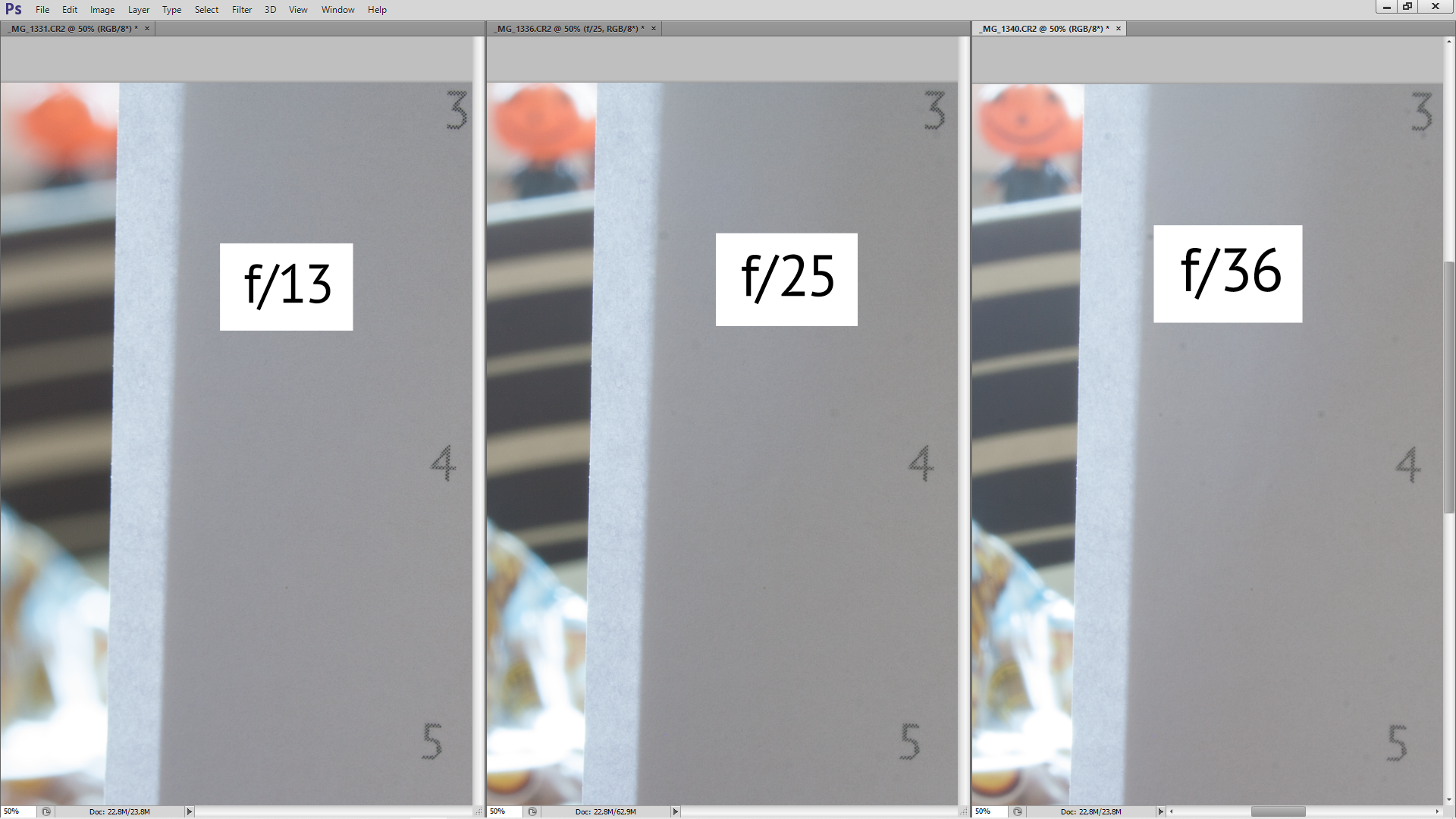
The number f/13 means that the aperture of the objective is half-closed. Take a closer look at the blurred background and compare it to the closed aperture (f/36). The background becomes sharper, and you may even distinguish my little Halloween figure. Does it mean that the smaller the opening, the better?
Not at all! Let’s take an even closer look at the text.
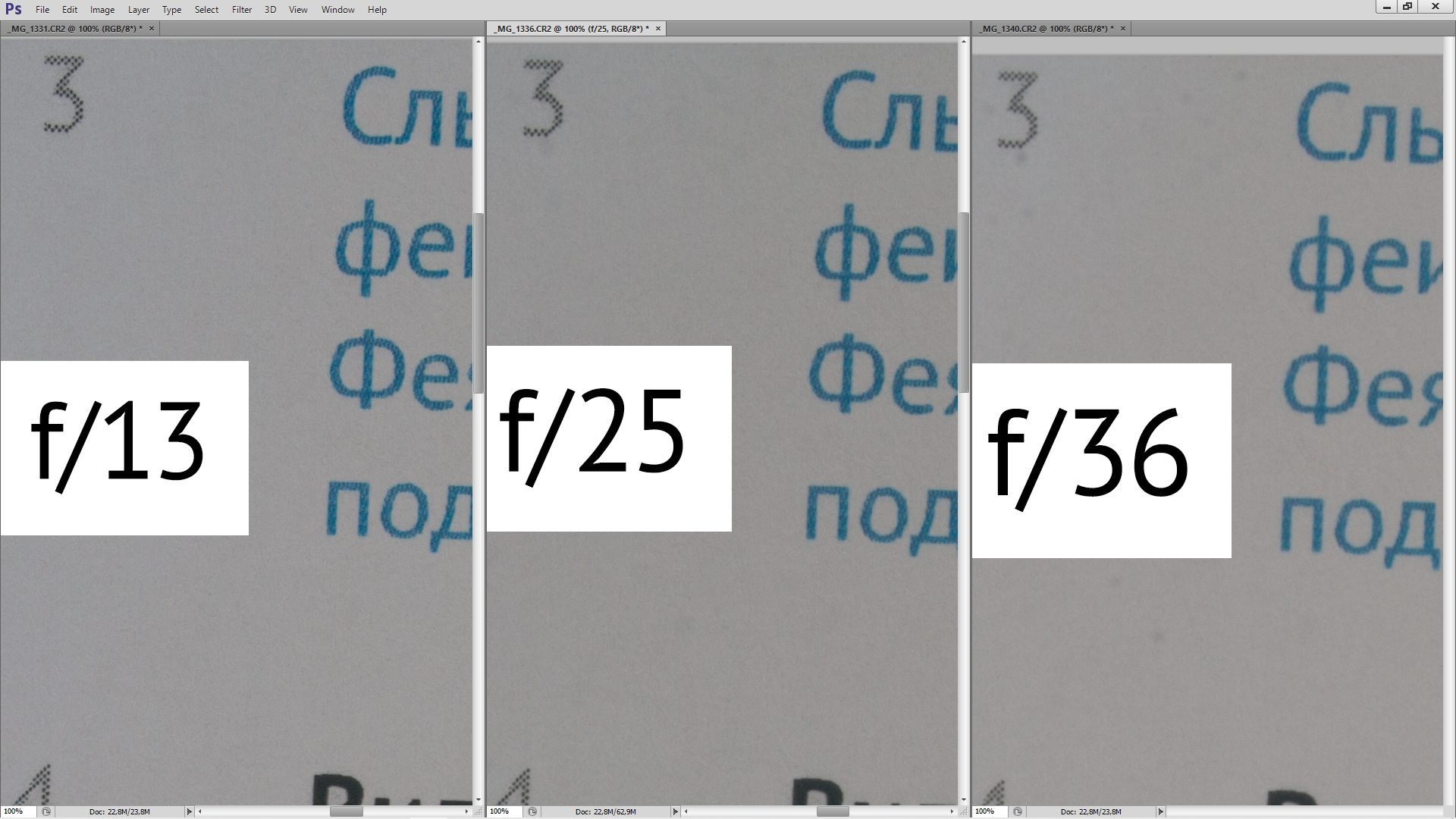
You may need to download the picture to see it. Let me show it even closer.
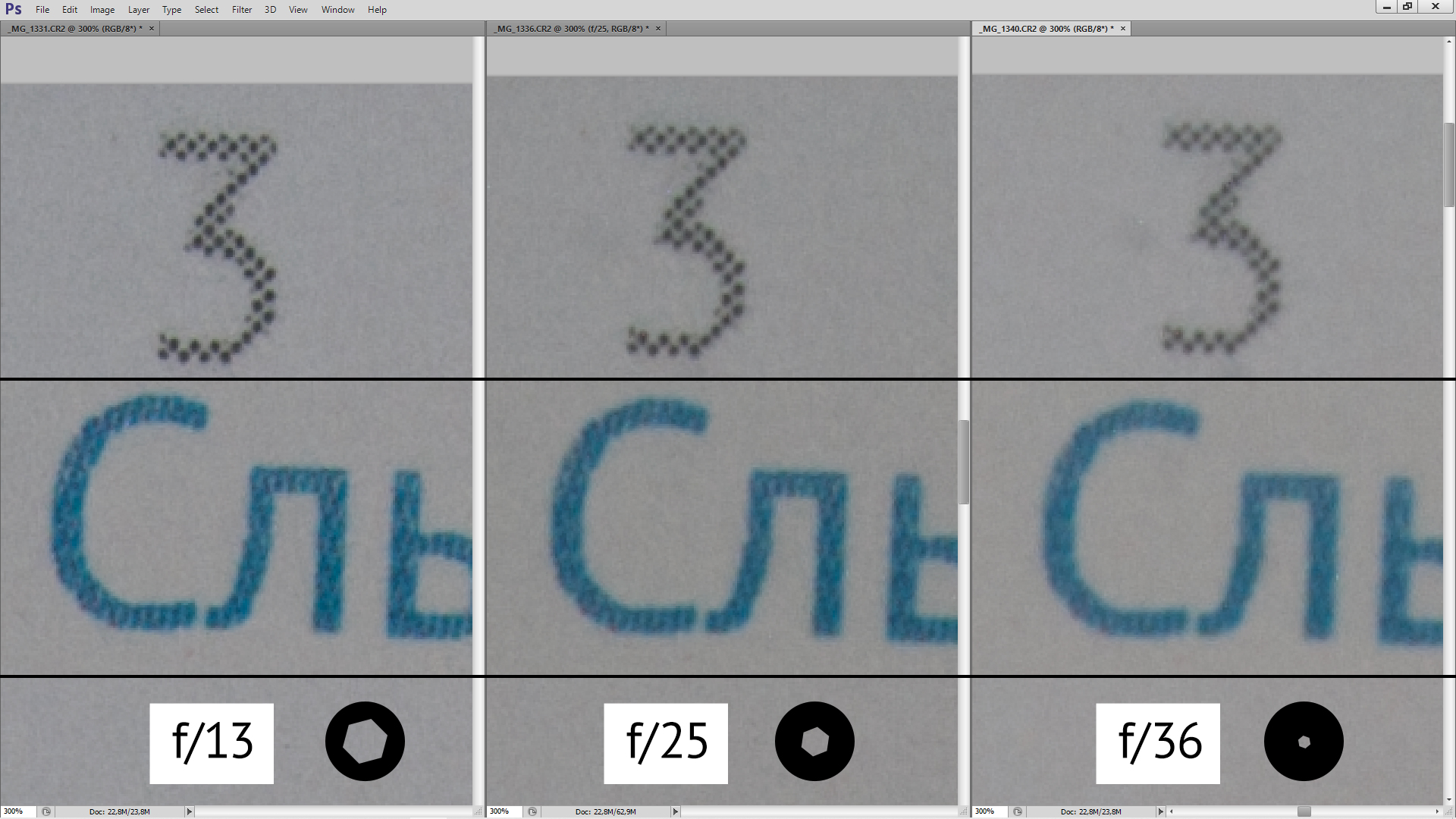
Notice, the small details become blurry, not because of the wrong focus. I focused on the image manually and kept the setting. Everything gets blurry because of the nature of the light itself. I encourage everyone to do this little experiment at home. To see the effect clearly, however, you’ll need a professional objective (mine isn’t great either, but just enough to see the diffraction a little bit).
Now let’s get back to the fairies’ vision. Using the Fraunhofer formula, we can calculate the angle at which the image details become blurry beyond recognition. As for the wavelength, let’s take a beautiful green light that’s about 540 nanometres.
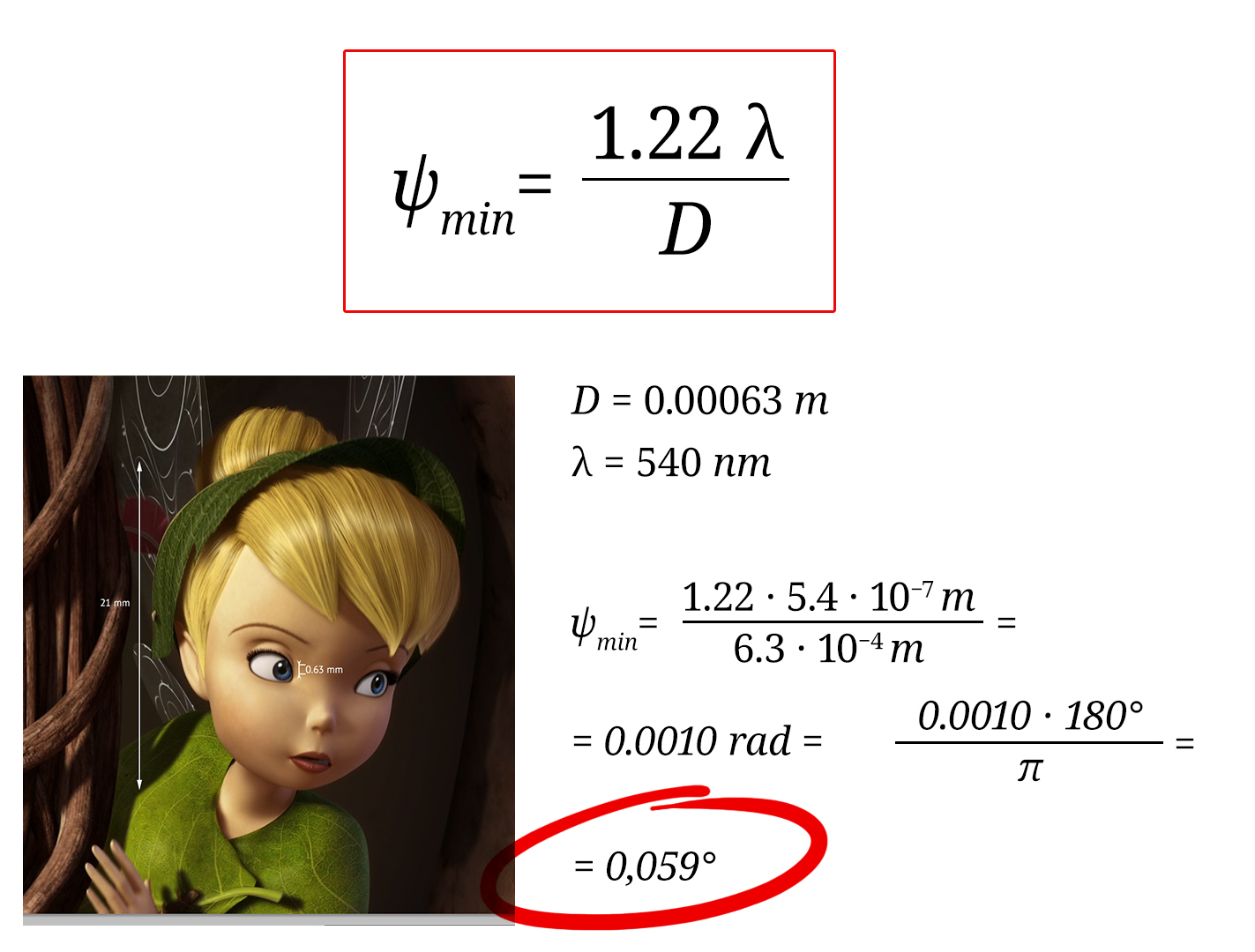
But what exactly means 0.059°? Let me illustrate it:
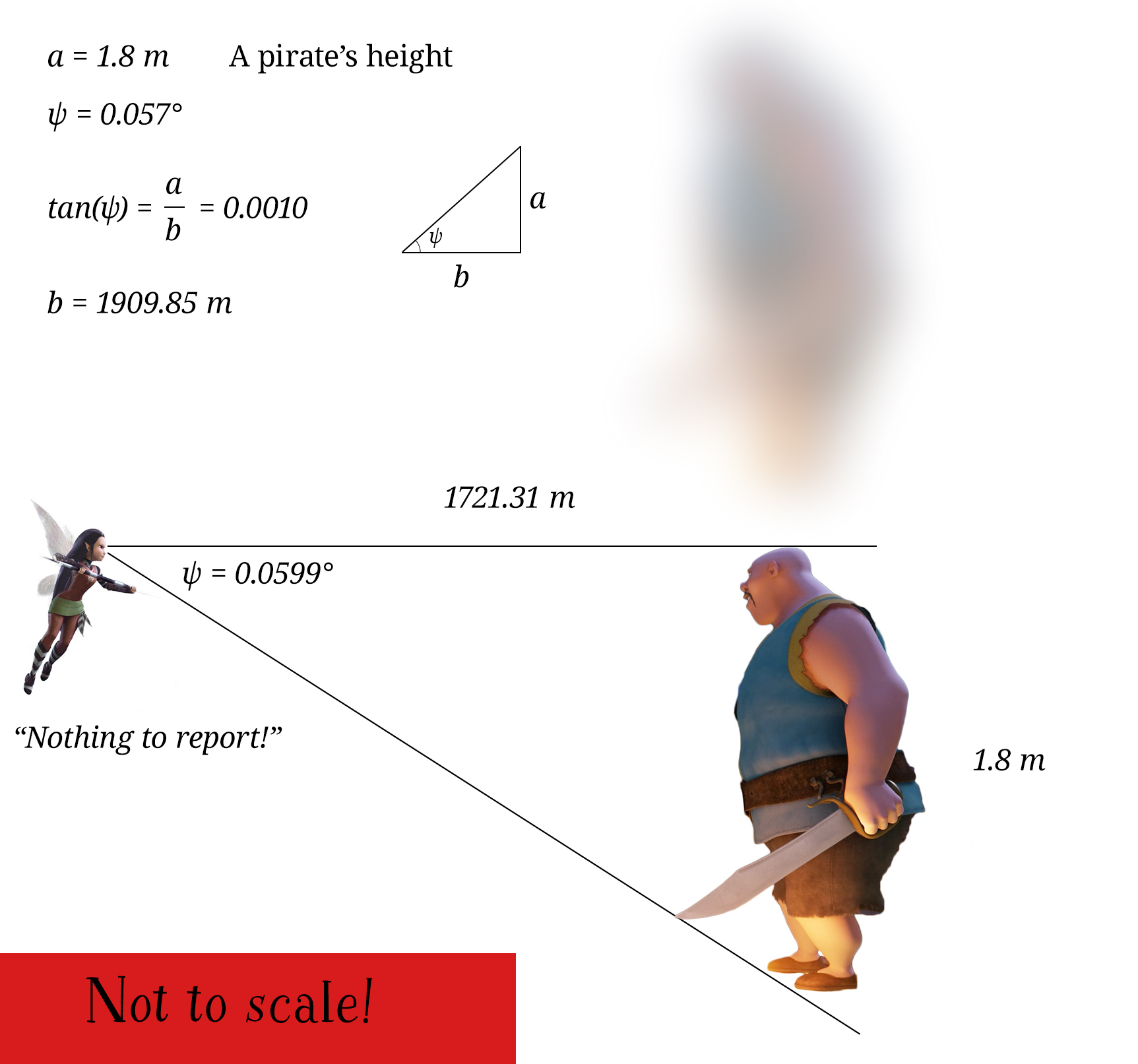
That means that a scout fairy will NEVER see a 1.8 m tall pirate from 2 km distance—he will be blurred completely. While a human scout would spot such a tall target from 3 km distance.
Source: https://www.livescience.com/33895-human-eye.html
Conclusion
A fairy’s vision allows seeing the microscopic details much better than a human can with the naked eye. Small pupil means that the image would appear darker. Sophisticated processing, however, can mitigate this issue. The refraction limit makes the eyesight less acute in comparison to a human eye, which makes the observation of distant objects and scouting, in general, more challenging.
Think about it! We managed to find out so much about fairies’ vision just by using some physics and mathematics!
Stay tuned for move scientific adventures!
— I thought… this is a fairy-tail…
— It is. But so what? Since this is a fairy-tail, what makes you think that the laws of physics stop working here? Imagine what would happen in a fairy-tail world if gravity would not work there. What about friction? Or if solar energy wouldn’t warm up Earth! Are aerodynamic laws any different in that sense?
”
Yury Nesterenko,
“A Hero, a Dragon and a Princess”
“A Hero, a Dragon and a Princess”
The acuity of fairies’ vision
Third Research
How clear can a fairy see? Can science help us with this question?
Yes, it can. And we don’t need to catch even one specimen for that. All we need to know is her pupil size. Thanks to our previous fairyology paper, we know that a fairy’s height is about 10 cm.

Easy enough. What now? Should we build a camera with such a tiny lens and take a couple of pictures? That would be great! Moreover, such cameras exist already. They are usually used for medical and engineering purposes. Take a look at this insect:
https://youtu.be/B3z5XV8iH9I
This is a clear hint that a fairy would see many microscopic details much, much better than a human. And it’s not a big surprise.

And what about panoramic views? Unfortunately, no one bothers filming anything with it other than tiny objects. This is the best recording I found:
https://www.youtube.com/watch?v=d0j3Ca7xoYA
If you have a similar camera, please conduct such an experiment and film an open area using it.
In this example, we can see a tiny bit of the room. And to be honest, the clarity is not too bad. Notice how dark it is. And you may already know why. The lens is tiny, and the poor sensor just doesn’t receive enough photons to show us a clear picture. The smaller the camera, the more noise and worse image quality we get.
Does it mean that a fairy sees everything darker and with such noise?
Not necessarily! You might have noticed that photographs become noisier in low light conditions, while a human eye doesn’t see this noise (although human’s pupil might be even smaller than an objective of a camera). Two final pieces of the puzzle are the sensors and the processing of the image. We can only speculate how a fairy’s retina works and how the signals are processed. Instead, let’s take a look at this demo:
https://youtu.be/qWKUFK7MWvg

Impressive? How is it possible to restore so many details from an almost dead photo? Well, one might hire digital artists (maybe from my team) and let them do the job, but in this case, we have something more interesting.
The new program benefits from the artificial neural networks, smart algorithms that somewhat resemble the human brain. First, the scientists show to the program a very dark photograph (a bad one) and the same image, but with the correct exposure (a good one). After showing several thousands of such bad and good pictures, the computer managed to “learn” how to restore dark, noisy images. Let me stress it: the machine could generalise the approach and use this “skill” to correct the new pictures never seen previously.
Source: http://cchen156.web.engr.illinois.edu/p ... PR_SID.pdf
That means that slightly darker world is not a big problem. A fairy can theoretically process the image, so it doesn’t look dark and noisy. Hey, you do it daily and don’t even notice it!
However, no processing can defeat the diffraction limit.
Don’t panic and let me explain what it means.
Granted that we don’t know what crystalline lens might fairies have, but we can measure their maximum possible acuity just by knowing the pupil size. All thanks to the wave nature of light.
Imagine water waves hitting the small opening:

Source: http://labman.phys.utk.edu/phys222core/ ... single.htm
Notice how parallel waves spread out and move radially. The smaller the opening, the more spread we get. Light behaves precisely like that with the only difference: the light waves are much, much smaller.
And how does the small opening affect the quality of the picture?
If we asked a photographer about small and large aperture (gap in the objective), he would start telling us about f-stops, exposure, depth of field and other stuff. However, almost everyone omits one important detail. Let me show you the diffraction limit in action. I printed out one page from the script of our next animated episode about Tink and Vidia. I printed the Russian version on purpose, so you don’t get distracted. Here it is:

The number f/13 means that the aperture of the objective is half-closed. Take a closer look at the blurred background and compare it to the closed aperture (f/36). The background becomes sharper, and you may even distinguish my little Halloween figure. Does it mean that the smaller the opening, the better?
Not at all! Let’s take an even closer look at the text.

You may need to download the picture to see it. Let me show it even closer.

Notice, the small details become blurry, not because of the wrong focus. I focused on the image manually and kept the setting. Everything gets blurry because of the nature of the light itself. I encourage everyone to do this little experiment at home. To see the effect clearly, however, you’ll need a professional objective (mine isn’t great either, but just enough to see the diffraction a little bit).
Now let’s get back to the fairies’ vision. Using the Fraunhofer formula, we can calculate the angle at which the image details become blurry beyond recognition. As for the wavelength, let’s take a beautiful green light that’s about 540 nanometres.

But what exactly means 0.059°? Let me illustrate it:

That means that a scout fairy will NEVER see a 1.8 m tall pirate from 2 km distance—he will be blurred completely. While a human scout would spot such a tall target from 3 km distance.
Source: https://www.livescience.com/33895-human-eye.html
Conclusion
A fairy’s vision allows seeing the microscopic details much better than a human can with the naked eye. Small pupil means that the image would appear darker. Sophisticated processing, however, can mitigate this issue. The refraction limit makes the eyesight less acute in comparison to a human eye, which makes the observation of distant objects and scouting, in general, more challenging.
Think about it! We managed to find out so much about fairies’ vision just by using some physics and mathematics!
Stay tuned for move scientific adventures!
21st February 2020
P. S. And don’t forget to subscribe to our YouTube channel!